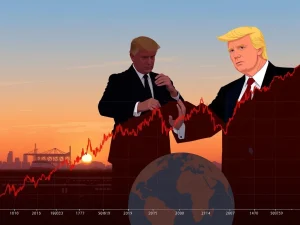Bitcoin Price Shows Strength, But Faces Critical Test at $110K Amid US Economy Concerns

Recent action has shown the Bitcoin price displaying notable strength, pushing towards the $108,500 level. This move has investors asking if bulls have the power to drive BTC price past the significant $110,000 mark. However, a closer look at the market reveals underlying caution among professional traders, influenced heavily by external economic factors.
Analyzing Recent Bitcoin Price Movement
Between June 7 and June 9, the Bitcoin price climbed 3.5%, nearing $108,500. Despite this positive movement, sentiment among professional traders remains reserved. This hesitation is visible in key market analysis indicators derived from Bitcoin derivatives.
- Bitcoin futures premiums for 2-month contracts have stayed close to the 5% neutral baseline since June 6. This suggests traders are not rushing to place aggressive bullish bets following the price increase.
- The market is currently trading just 3% below its May 22 high of $111,965, yet this proximity to a record has not triggered widespread bullish speculation.
- Importantly, the recent price rise appears built on a healthy foundation, not excessive leveraged positions.
Macroeconomic Headwinds Impacting the Crypto Market
One of the primary challenges facing the crypto market, and specifically Bitcoin, is its continued strong relationship with traditional financial assets. Bitcoin currently shows an 82% correlation with S&P 500 futures over the past 50 days. This means Bitcoin’s price movements often mirror those of the stock market.
This persistent correlation means investors often view Bitcoin as a risk-on asset, similar to stocks, rather than a safe haven. This perspective can limit upside potential when broader economic uncertainty increases.
US Economy Concerns Cap BTC Price
Fears surrounding the US economy are a significant factor potentially capping the BTC price below $110,000. Concerns include:
- Potential for a US recession.
- Lingering impact of high interest rates.
- Uncertainty related to global trade tensions.
- Worries about the US government’s ability to manage its growing national debt.
Historically, periods of intense US trade conflict have negatively affected nearly all asset classes, including Bitcoin. As long as these macroeconomic pressures persist, Bitcoin’s close tie to traditional markets makes it vulnerable to downward pressure, making a sustained move above $110,000 difficult.
Derivative Insights and Market Analysis
Further market analysis from derivatives platforms provides insight into trader positioning. On OKX, the Bitcoin margin long-to-short ratio shows longs outweighing shorts by 4 times. While this indicates more traders are betting on a price increase than a decrease, it’s far from the excessive confidence levels (above 20 times) seen in historical tops. Levels below 5 times favoring longs can even be interpreted as bearish by some.
However, it is worth noting that these indicators do not currently suggest large players are positioning for a significant price crash.
Long-Term Potential vs. Short-Term Reality for Bitcoin
Some analysts remain optimistic about Bitcoin‘s long-term potential, particularly in the context of rising US national debt. They argue that weakening confidence in the US Treasury could lead to capital shifting out of government bonds. Given Bitcoin’s relatively small market size compared to the S&P 500 ($50 trillion) or gold ($22.5 trillion), capturing even a small fraction of these potential outflows could theoretically propel Bitcoin past $150,000.
However, the short-term outlook remains constrained. As long as the US dollar maintains its role as the world’s reserve currency, Bitcoin’s price is susceptible to macro pressures. The prevailing concerns about the global economic landscape are likely to limit Bitcoin’s immediate upside, potentially keeping it below the $110,000 threshold for now.
In conclusion, while the recent strength in Bitcoin price is encouraging, the path above $110,000 faces significant hurdles. The strong correlation with the stock market and persistent fears regarding the US economy mean that broader macroeconomic conditions are key determinants of short-term price action. Traders remain cautious, as reflected in market analysis of derivatives data. While the long-term case for Bitcoin in an environment of fiscal instability exists, navigating the current economic climate presents a critical test for bulls aiming to push prices higher in the immediate future.








